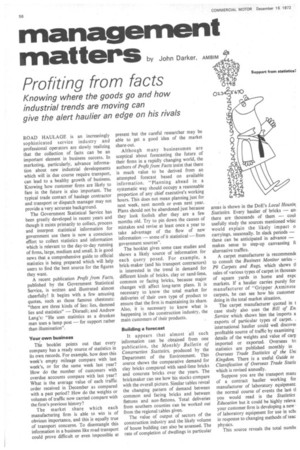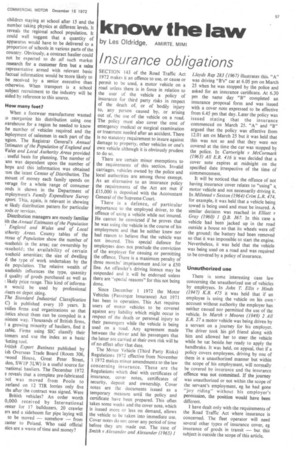management
Page 58

Page 59

If you've noticed an error in this article please click here to report it so we can fix it.
matters by John Darker, AMBIM
Profiting from facts
Knowing where the goods go and how industrial trends are moving can give the alert haulier an edge on his rivals
ROAD HAULAGE is an increasingly sophisticated service industry and professional operators are slowly realizing that the collection of facts can be an important element in business success. In marketing, particularly, advance information about new industrial developments which will in due course require transport, can lead to a healthy growth of business. Knowing how customer firms are likely to fare in the future is also important. The typical trade contact of haulage contractor and transport or dispatch manager may not provide a very accurate background.
The Government Statistical Service has been greatly developed in recent years and though it exists primarily to collect, process and interpret statistical information for government use there is now a conscious effort to collect statistics and information which is relevant to the day-to-day running of firms, large, medium and small. It is good news that a comprehensive guide to official statistics is being prepared which will help users to find the best source for the figures they want.
A recent publication Profit from Facts, published by the Government Statistical Service, is written and illustrated almost cheerfully! It begins with a few amusing quotes, such as those famous chestnuts: "there are three kinds of lies: lies, damned lies and statistics" — Disraeli; and Andrew Lang's: "He uses statistics as a drunken man uses a lamp post — for support rather than illumination".
Your own business The booklet points out that every company has a ready source of statistics in its own records. For example, how does this week's empty mileage compare with last week's, or for the same week last year? How do the number of customers with overdue accounts compare with last year? What is the average value of each traffic order received in December as compared with a past period? How do the weights or volumes of traffic now carried compare with the firm's previous history?
The market share which each manufacturing firm is able to win is of obvious importance, and this is equally true of transport concerns. To disentangle this information in a business like road transport could prove difficult or even impossible at present but the careful researcher may be able to get a good idea of the market share-out.
Although many businessmen are sceptical about forecasting the future of their firms in a rapidly changing world, the authors of Profit from Facts insist that there is much value to be derived from an attempted forecast based on available information. "Planning ahead in a systematic way should occupy a reasonable proportion of any chief executive's working hours. This does not mean planning just for next week, next month or even next year. Plans should not be abandoned just because they look foolish after they are a few months old. Try to pin down the causes of mistakes and revise at least once a year to take advantage of the flow of new information — some of it statistical — from government sources".
The booklet gives some case studies and shows a likely source of information for each query posed. For example, a brick-maker (and his transport contractors) is interested in the trend in demand for different kinds of bricks, clay or sand-lime, common or facing bricks, because major changes will affect long-term plans. It is necessary to know the total market for deliveries of their own type of product to ensure that the firm is maintaining its share. Also, it is necessary to know what is happening in the construction industry, the main customers of their products.
Building a forecast
It appears that almost all such information can be obtained from one publication, the Monthly Bulletin of Construction Statistics, produced by the Department of the Environment. This source shows the comparative demand for clay bricks compared with sand-lime bricks and concrete bricks over the years. The brickmaker can see how his stocks compare with the overall picture. Similar tables reveal the changing pattern of demand between common and facing bricks and between fiettons and non-flettons. Total deliveries from southern counties can be worked out from the regional tables given.
The value of output of sectors of the construction industry and the likely volume of house building can also be assessed. The rate of completion of dwellings in particular
areas is shown in the DoE's Local Housin, Statistics. Every haulier of bricks — there are thousands of them — coul usefully study the sources mentioned whic would explain the likely impact o carryings, seasonally. In slack periods — these can be anticipated in advance — makes sense to step-up canvassing ft alternative traffics.
A carpet manufacturer is recommend( to consult the Business Monitor series P9 Carpets and Rugs, which shows tl sales of various types of carpet in thousan of square yards in home and expc markets. If a haulier carries purely for manufacturer of "Gripper Axminste carpets, he can see how his customer doing in the total market situation.
The carpet manufacturer quoted in t case study also uses the Bill of En, Service which shows him the imports a exports of particular types of carpet. , international haulier could well discovei profitable source of traffic by examining details of the weights and value of carp imported or exported. Overseas tr; statistics are published monthly in Overseas Trade Statistics of the Uni Kingdom. There is a useful Guide to Classification of Overseas Trade Statis which is revised annually.
Suppose you are the transport maw of a contract haulier working for manufacturer of laboratory equipment the normal course of events the last ti you would read is the Statistics Education but it could be highly releva your customer firm is developing a new of laboratory equipment for use in sch( in response to changing methods of teac physics.
This source reveals the total numb( children staying at school after. 15 and the number taking physics at different levels. It reveals the regional school population. It could well suggest that a quantity of apparatus would have to be delivered to a proportion of schools in various parts of the country. Obviously, a contract haulier could not be expected to do all such market research for a customer firm but a sales representative armed with relevant basic factual information would be more likely to be received by a senior executive than otherwise. When transport is a school subject recruitment to the industry will be aided by reference to this source.
How many feet?
When a footwear manufacturer wanted so reorganize his distribution using one warehouse for a region he needed to know he number of vehicles required and the leployment of salesmen in each part of the .egion. The Registrar General's Annual Fstimates of the Population of England and Vales and Local Authority Areas provided • useful basis for planning. The number of ans was dependent upon the number of hops and this information was obtained -om the latest Census of Distribution. The mount of money each family spends on verage for a whole range of consumer Dods is shown in the Department of mployment's Family Expenditure Survey eport. This, again, is relevant in showing ie likely distribution pattern for particular oods or services.
Distribution managers are mostly familiar ith the Annual Estimates of the Population ' England and Wales and of Local whority Areas. County tables of the ?nsus of Population show the number of luseholds in the area; car ownership by lusehold; the availability of certain usehold amenities; the size of dwelling d the type of work undertaken by the tle population. The relative wealth of useholds influences the type, quantity d quality of goods purchased as well as likely price range. This kind of informan would be used by professional users on depot siting.
The Standard Industrial Classification C) is published every 10 years. It ssifies firms and organizations so that isties about them can be compiled in a isistent way. Thousands of British firms, I a growing minority of hauliers, find it 'able. Firms using SIC classify their tamers and use the index as a basic -keting tool.
?dash Export Business published by ish Overseas Trade Board (Room 306, rwood House, Great Peter Street, don, SW IP 3LW) is a useful source for motional hauliers. The December 1972 reveals that a complete pre-fabricated ool was moved from Poole to zerland on 12 TIR lorries only five ths after the contract was signed. Were British vehicles? An order worth 0,000received by International /ester for 17 bulldozers, 20 crawler ers and a sideboom for pipe laying will to be moved — somehow — from ;saster to Poland. Who said official ;tics are a waste of time and money?




































































































